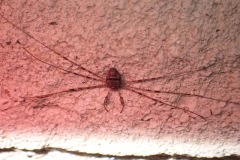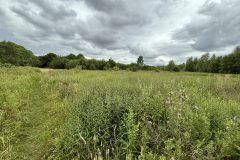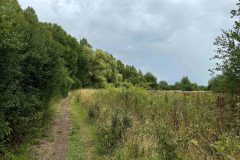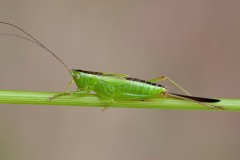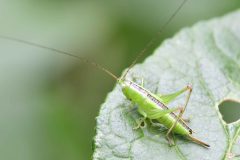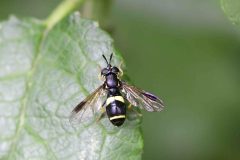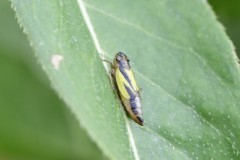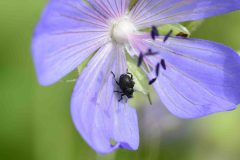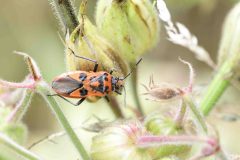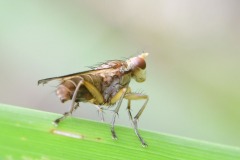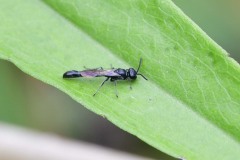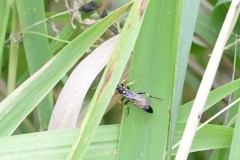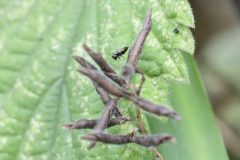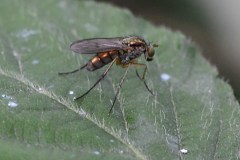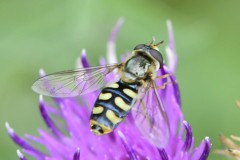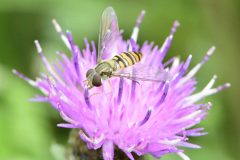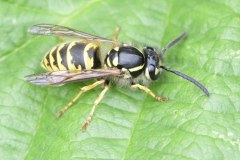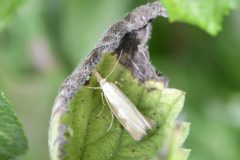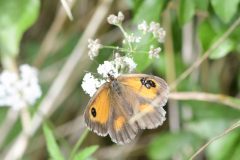Meeting Reports July 2025
Objective : To monitor Green-flowered Helleborine Orchids and listen for Bush Crickets and Bats
Leader : Catherine Palmer and Colin Howes.
Other Attendees : Graham & Samantha Batty, Joyce & Paul Simmons.
After street parking at the bottom of Wroxham Way and Walsham Drive (SE551040: DN5 8JX) we cut through the snicket to access the Country Park, assembling outside the Keeper’s Cottage at 6:30 PM.
Due to the dazzling evening sun, Catherine lead us round the west side of the lower lake and, though not expecting to find many Helleborines due to the prolonged drought, managed to find 33 specimens, 22 on the west side and 11 on the east side of the lake, all being within inches of the woodland path.
We then walked along the mown pathways through the tall fen/meadow vegetation on the way to the main lake. Though no bats were about at this early time, the bat detector registered loud grating, staccato calls (at 20-22kH) of at least two species of Bush Crickets. These were in dense growths of grasses and sedges, the performing specimens remaining well out of sight.
We walked slowly up to the Hall via the steep path on the east side of the park, through the flower beds, shrubberies and specimen trees. It was still a little early for bat activity and there were no pre-emergence bat utterances from the venerable Beeches and Sycamores around the Hall, though one item of fascination was the elderly Strawberry Tree Arbutus unedo.
We wandered around the Hall (avoiding the raucous gathering in the Cusworth Old Brewhouse), emerging at the rear of the Bothy. Here on the new limestone of a recently restored historic gate post, we encountered at least 76 empty puparia of Harlequin Ladybirds. In photographing this curious phenomenon, Joyce also photographed amongst them the extraordinary physique of the Harvest-spider Dicranopalpus ramosus with its characteristic ‘tuning-fork’ shaped palps. This Continental species only began to appear in Yorkshire in the early 2000s (see YNU Bulletin (2007) 47: 12-14.).
We returned to the Keepers Cottage and the Lower Lake via Cusworth Lane and Orchard Lane, again registering Bush Cricket calls from the un-cut meadow. Then by the Lower Lake, at the approach of 10pm, Samantha registered a Daubenton’s Bat on her Echo Meter Touch 2 digital Bat detector and shortly after there were Common Pipistrelle clicks at 45kH on my ancient dilapidated Stag Electronics Bat Box Bat detector, these trawling flying insects at head-height along the paths through the surrounding trees and shrubs.
Many thanks to all who took part, and particularly to Catherine for expertly finding the Helleborines and getting us off to a good start.
CAH.
Meet : 1.30 pm in Morrison’s (Balby) Supermarket car park, gathering outside the Laundry machines behind the Garden Centre (Grid ref. SE579 005 Postcode DN4 5JP).
Leader : Colin Howes & Nora Boyle.
Other Attendees : Graham & Samantha Batty; John Neep & Les Coe.
Reason for survey: On behalf of Melissa Massarella, Doncaster City Biodiversity Officer, Louise Hill suggested the Nats survey the ‘Wilded’ land between the commercial/industrial developments along Water Vole Way (to the north-east) and the recent housing developments around Blossom Crescent off Woodfield Way (to the south). The reason for the data gathering being to provide evidence of the survival of locally relevant biodiversity and rural amenity in this increasingly built-over part of Doncaster.
Site History: This strip of land approximately 860m long by between 125m and 259m wide, was formerly (Georgian & Victorian eras) part of one of the Balby Carr Farms (now demolished) and its most recent use (1950s & 60s) had been as a Local Authority-run Golf Course.
Recollections: As chance would have it, as a small child, Graham Batty lived at the Golf House (now demolished), his father being the site manager/greens keeper. The splendid population of boundary Poplars which currently form the north-eastern backcloth to the site were all planted by his father, so too were many of the trees around the site of the golf house. Graham remembers Little Owls breeding in an Ash tree by the Golf House and Frogs, Great crested Newts (which he referred to as salamander newts) and Bullheads in the Division Drain which forms part of the site’s southern boundary. Interestingly, our friend Michael Jackson (ex Museum joiner) who also shared a 1950s childhood roaming the Balby Carr/Woodfield area, remembered Sticklebacks, Frogs, Great crested Newts and Grass Snakes in the local field drains.
Survey Location: The area consists of ‘wilded’ land surrounded by mature and over-mature boundary Poplars. There is a good range of shrubs and zones of tall ruderals. To date this seems to be the first natural history survey, so all records are going to be useful. The pond has developed a good range of aquatic vegetation and has attracted Common Terns, Cetti’s Warbler, migrating House Martins and Doncaster’s first wild record (3 Oct. 2022) of Water Lettuce or Nile Cabbage Pistia stratiotes.
We followed the main (strimmed) path network (some of it tarmacked!) around the artificial (designer) lake (SE579004) and north up towards the rear of the Astrea Academy, Woodfield (formerly Woodfield High School and Balby Carr Community Academy) to the junction with Weston Road (SE572006) and Woodfield Road/ Goldsmith Road (SE572009).
Species encountered during our brief visit (all from within the 1km square SE5700) are listed in the following tables but my personal highlights were as follows.
In tall grasses (mainly Deaschampsia cespitosa) by the balancing reservoir, Samantha Batty heard, then saw several nymphs of the Long-winged Conehead Conocephalus fuscus. This is a type of bush-cricket, identifiable by its long, brown wings, green body with a brown stripe down its back, and distinctive pointed head. It is known for its high-pitched, buzzing song, which can be difficult for most people to hear. Not only could I not hear these insects, I couldn’t even see them camouflaged amongst the grass stems, even when pointed out (!). I retrieved my ancient dilapidated Bat Detector from the car and returned to find the crickets stridulating loudly at 20-22kH. This species is found in grasslands, heaths, and damp coastal areas and probably due to warmer summers, is spreading northwards. The Bat detector proved invaluable, detecting populations of these crickets and other as yet unidentified Orthopterans in most of the areas of tall grasses. A very fine photograph taken by Samantha, of a female Conehead with its characteristically long, straight ovipositor, features on the DNS website after this report.
The botanical highlight came from the piles of vegetation deposited by the Local Authority on the concrete/tarmac hard standing on the site of the old Golf House. Here the grass-cuttings and prunings are left to turn into compost. The crowning glory on top of a 2m high compost heap, were the large creamy white trumpets of a fine Thorn Apple shrub Datura stramonium.
The Woodfield Green Triangle has proved to be a very promising natural history site and DNS members are encouraged to make other ad-hock visits at different times of year … perhaps while supporting sporting events at the Astrea Academy or shopping at Morrisons.
* Or as Claud Debussy might have put it … “L’après-midi d’un Conehead”
CAH.
A Conehead nymph was collected by Samantha allowing a photograph to be taken. This was a nymph of the Long-winged Cone-head (Conocephalus fuscus).
| Vernacular Name | Taxonomic Name |
| Trees, Shrubs & Climbers | |
| Ash | Fraxinus excelsior |
| Birch (Silver) | Betula pendula |
| Blackthorn | Prunus spinosa |
| Bramble | Rubus frutucosus agg. |
| Buddleia | Buddleja davidii |
| Cherry (flowering) | Cerasus serrulata |
| Cotoneaster sp. | Cotoneaster sp. |
| Crack Willow | Salix x fragilis |
| Dogwood | Cornus sanguinea |
| Elder | Sambucus niger |
| Field Maple | Acer campestre |
| Goat Willow | Salix caprea |
| Guelder Rose | Viburnum opulus |
| Hawthorn | Crataegus monogyna |
| Hazel | Corylus avellana |
| Holly | Ilex aquifolium |
| Hornbeam | Carpinus betulus |
| Ivy | Hedera helix |
| Leyland Cypress | Cupressocyparis leylandii |
| Lime | Tilia x europaea |
| Maple (Norway) | Acer platanoides |
| Maple (Silver) | Acer saccharinum |
| Oak (Common Pedunculate) | Quercus robur |
| Oak (Sessile) | Quercus petraea |
| Poplar (Grey) | Populus alba x tremula |
| Poplar (Lombardy) | Populus nigra var. italica |
| Rose (Burnet) | Rosa pimpinellifolia |
| Rose (Dog) | Rosa canina |
| Rowan | Sorbus aucuparia |
| Sycamore | Acer pseudoplatanus |
| Sycamore (Variegated) | Acer pseudoplatanus f. variegatum |
| Herbs | |
| Annual Meadow-grass | Poa annua |
| Barren Brome | Bromus sterilis |
| Bird’s-foot Trefoil | Lotus corniculatus |
| Black Horehound | Ballota nigra |
| Black Knapweed | Centaurea nigra |
| Black Medic | Medisago lupulina |
| Black Nightshade | Solanum nigrum |
| Bristly Ox-tongue | Helminthotheca echioides |
| Broad Dock | Rumex obtusifolius |
| Bryony (Black) | Discorea communis |
| Bryony (White) | Bryonia dioica |
| Buttercup (Creeping) | Ranunculus repens |
| Buttercup (Meadow) | Ranunculus acris |
| Cleavers | Galium aparine |
| Clover (Red) | Trifolium pratense |
| Clover (White) | Trifolium repens |
| Cock’s-foot grass | Dactylis glomerata |
| Common Bent grass | Agrostis capillaris |
| Common Comfrey | Symphytum officinalis |
| Common Fleabane | Pulicaria dysenterica |
| Common Mallow | Malva sylvetris |
| Common Reed | Phragmites australis |
| Common Sorrel | Rumex acetosa |
| Common Vetch | Vicia sativa |
| Cow Parsley | Anthriscus sylvestris |
| Dandelion | Taraxacum obtusifolius |
| Deadnettle (Red) | Lamium purpureum |
| Deadnettle (White) | Lamium album |
| Dove’s-foot Cranesbill | Geranium molle |
| False Oat-grass | Arrhenatherum elatius |
| Fat Hen | Chenopodium album |
| Feverfew | Tanacetum parthenium |
| Field Horsetail | Equisetum arvense |
| Foxglove | Digitalis purpurea |
| Garlic Mustard | Alliaria petiolata |
| Good King Henry | Chenopodium bonus-henricus |
| Great Willowherb | Epilobium hirsutum |
| Groundsel | Senecio vulgaris |
| Hedge Bedstraw | Gallium mollugo |
| Hedge Mustard | Sisymbrium officinale |
| Hemlock | Conium maculatim |
| Hogweed | Heracleum sphondylium |
| Honeysuckle | Lonicera periclymenum |
| Indian Balsam | Impatiens glandulifera |
| Iris (Stinking) | Iris foetidissima |
| Iris (Yellow) | Iris pseudacorus |
| Knotgrass | Polygonum aviculare |
| Lesser Burdock | Arctioum minus |
| Meadow Cranesbill | Geranium pratense |
| Meadow Foxtail | Alopecurus pratensis |
| Meadowsweet | Filipndula ulmaria |
| Melilot (Ribbed) | Melilotus officinalis |
| Melilot (White) | Melilotus albus |
| Michaelmas Daisy | Aster amellus var.
Syn. = Symphyotrichum novi-belgii |
| Mugwort | Artemisa vulgaris |
| Nipplewort | Lapsana communis |
| Opium Poppy | Papava somnifrum |
| Ox-eye Daisy | Leucanthemun vulgare |
| Perennial Sow-thistle | Sonchus arvensis |
| Pineapple-weed | Matricaria discoidea |
| Plantain (Rat-tail) | Plantago major |
| Plantain (Ribwort) | Plantago lanceolata |
| Prickly Lettuce | Lactuca serriola |
| Prickly Sow Thistle | Sonchus asper |
| Purple Loosestrife | Lythrium salicaria |
| Ragwort (Common) | Jacobaea vulgaris |
| Ragwort (Oxford) | Senecio squalidus |
| Red Bartsia | Odontites vernus |
| Rosebay | Chamerion angustifolium |
| Rye Grass | Lolium perenne |
| Shepherds Purse | Capsella bursa-pastoris |
| Silverweed | Potentilla anserine |
| Spiked Water Milfoil | Myriophyllum spicatum |
| Stinging nettle | Urtica dioica |
| Sun Spurge | Euphorbia helioscopia |
| Thistle (Creeping) | Circium arvense |
| Thistle (Spear) | Cirsium vulgare |
| Thorne Apple | Datura stramonium |
| Timothy | Phleum pratense |
| Tufted Hair-grass | Deschampsia cespitosa |
| Upright Hedge Parsley | Torilis japonica |
| Wall Barley | Hordeum murinum |
| Water Mint | Mentha aquatica |
| Weld | Reseda luteola |
| White Campion | Silene latifolia |
| Wild Carrot | Daucus carota |
| Yarrow | Achillea millefolium |
| Yorkshire Fog | Holcus lanatus |
| BIRDS | ||
| Blackbird | Turdus merula | |
| Carrion Crow | Corvus corone | |
| Dunnock | Prunella modularis | |
| Magpie | Pica pica | |
| Sedge Warbler | Acrocephalus schoenobaenus | |
| Song Thrush | Turdus philomelos | |
| Wood Pigeon | Columba palumbus | |
| FISH | ||
| 3-spined Stickleback | Caught by local lads, fishing. | |
| Roach | “ | |
| Rudd | “ | |
| MAMMALS | ||
| Mole (hills) | Talpa europaea | |
| Rabbit (droppings) | Oryctolagus cuniculus | |
| INVERTEBRATES | Confirmed by photographs | |
| Lepidoptera (Butterflies & Moths) | ||
| A Grass Moth | Agriphila straminella | Les Coe |
| Gatekeeper Butterfly | Pyronia tithonus | |
| Meadow Brown Butterfly | Maniola jurtina | |
| Peacock Butterfly | Agalis io | |
| Small Copper Butterfly | Lycaena phlaeas | |
| Small Tortoiseshell Butterfly | Aglias urtcae | |
| Small White Butterfly | Pieris rapae | |
| Speckled Wood Butterfly | Pararge aegeria | |
| Hemiptera (Bugs) | ||
| Hawthorn Shield Bug | Acanthosoma haemorrhoidale | Les Coe |
| A black & yellow Leaf Hopper | Evacanthus interruptus | Les Coe |
| Cinnamon Bug | Corizus hyoscyami | Les Coe |
| Dock Aphid | Aphis rumicis | CAH |
| Coleoptera (Beetles) | ||
| 16-spot Ladybird | Tytthaspis 16-punctata | |
| 7-spot Ladybird | Coccinella 7-punctata | |
| Green Dock Beetle | Gastrophysa viridula | CAH |
| Harlequin Ladybird | Harmonia axyridis | |
| Meadow Cranesbill Weevil | Zacladus geranii | Les Coe |
| Soldier Beetle | Rhagonycha fulva | Les Coe |
| Hymenoptera (Bees & Wasps) | ||
| Common Wasp | Vespa vulgaris | Les Coe |
| Slender Wood-borer Wasp | Tripoxylon attenuatum | Les Coe |
| Diptera (Flies) | ||
| A Black Scavenger or Ensign Fly | Sepsis sp. | Les Coe |
| A Dolichopodid Fly | Dolichopus sp. | Les Coe |
| A Hoverfly | Epistrophe sp. | Les Coe |
| A Hoverfly | Eupeodes sp. | Les Coe |
| A Hoverfly | Syrphus ribesii | CAH |
| A Hoverfly | Xylota segnis | Les Coe |
| A Snail-killer Fly | Tetanocera sp. | Les Coe |
| Marmalade Hoverfly | Episyrphus balteatus | CAH |
| Rose leaf-folding Fly | Dasineura rosae | Les Coe |
| Two-banded Spearhorn Hoverfly | Chrysotoxum bicinctum | Les Coe |
| Orthoptera (Grasshoppers & Crickets) | ||
| Long-winged Conehead | Conocephalus fuscus | Samantha Batty |
| Arachnida (Spiders) | ||
| Candy-stripe Spider (yellow form) Many on Bramble leaves. | Enoplognatha ovata | CAH |
| Plant Galls | ||
| Artichoke Gall on Common Oak | Andricus foecundatrix (gall wasp). | Nora Boyle |
| Cherry gall on underside of Common Oak leaves | (Cynips quercusfolii (Gall wasp). | Nora Boyle |
| Gall on Silver Maple leaves | Vasates quadripedes (Mite) | CAH |
| Marble Gall on Common Oak | Andricus kollari (gall wasp). | Nora Boyle |
| Pustule galls on Willow leaves | Iteomya major (gall midge). | Nora Boyle |
| Silk Button Galls On underside of Common Oak leaves | Neuroterus numismalis (Gall wasp). | Nora Boyle |
| Mollusca | ||
| Brown-lipped Snail | Cepaea nemoralis | CAH |
| Common Garden Snail | Helix aspersa | CAH |
Nora Boyle & Colin Howes
Doncaster Naturalists’ Society.
July 2025
Meet : 6.00 pm at the farm DN6 0DL (SE605134)
Leader : John Scott
Purpose : This evening visit is to look for Purple Hairstreaks in the oak trees and try pond dipping again (we did this last year with excellent results), as well as trying out the new bat detecting device. (This can also be used to find Bush Crickets.)
Saw-Wort, Marsh Pea and Weasel Snout
Visits to John Scott’s Ash Hill Farm at Hawkhouse Green, with its green lanes, thick blousy hedgerows, stately white willows, ponds and bluebell-carpeted woodland are endlessly fascinating, particularly if accompanied by the boundlessly knowledgeable man himself.
As a latecomer to John’s farm visit on the evening of 14 July 2025, I missed our group heading out to do the advertised pond dipping and Purple Hair-streak spotting.
Looking across the meadows for any sign of our group, I noticed a movement which my binoculars revealed was John’s herd of Gloucester/Hereford cattle rounding a hedge two fields away and presumably due to the prolonged and intense drought, were heading back home for supplementary feed. Watching them was fascinating. The group consisted of cows, surrounding their calves, all being nudged along by the substantial bulk of the Hereford Bull bringing up the rear.
I headed out along the strimmed green lanes and quickly encountered Peacock, Small Tortoiseshell, Meadow Brown, Gatekeeper, Small White and Ringlet butterflies. Through the evening, forbidding rainclouds gathered in the northeast, however, as the sun sank lower in the sky this had the effect of illuminating the massive combined canopies of hedgerow Ash, Oak and particularly White Willows and contrasting them against the brooding black/purple clouds.
In returning to the car parked at Ash Hill Farm to retrieve the Bat Detector to listen out for Bush Crickets and eventually bats, I found the device had been left switched on so the battery was flat.
Meanwhile the cattle had reached the circular food hopper and everyone, including the calves had fed on the supplementary hay. The excited calves were skipping and chasing like a bunch of school children at playtime while their mothers were contentedly munching.
In that the Nats had not returned from pond-dipping, I journeyed back to Askern for a replacement battery and a sandwich from the Co-op.
On returning to Ash Hill, I found that the calves, exhausted by their earlier frolicking, were gathered together, asleep on the ground, their gangly limbs folded up beneath them like deck chair legs while their standing parents continued to munch … a vision bovine of contentment.
The Nats returned from their wanderings, some leaving for home and some joined the ever hospitable John for a cup of tea and a look around his garden. Botanical highlights included the reddish-purple thistle-like Saw-wort Serratula tinctoria, Marsh Pea Lathyrus palustris (Inkles Moor, Thorne being one of its last UK locations), and Weasel’s Snout Misopates orontium its pink flowers resembling miniature snapdragons. Meanwhile, John’s words of wisdom were being drowned out by piercing utterances from next doors very loud and vocal cockerel.
Our too early attempts at bat detecting picked up a mysterious slow tick-tick-tick at 20kh which turned out to be the electric fence keeping livestock out of John’s garden! However, John climbed up into the farm loft where a colony of Brown Long-eared bats had been known, and gathered up a handful of discarded moth wings most of which were from Yellow Underwing moths, these providing evidence of substantial meals for these relatively large bats.
Thanks are due to John for devoting his time, knowledge and initiative to making this such an interesting and enjoyable evening.
CAH
Meet: 1.30 pm on Pit Lane (near Treeton Village Community Centre). S60 5QY
Leader : Louise Hill
This will be a joint meeting with the South Yorkshire Botany Group
Details of proposed walk
From the meeting point we will take a short walk through the housing estate to the footpath at the western end of the Treeton Tip. The tip is a naturally-restored colliery spoil heap on the northern edge of Treeton Village with areas of lowland heath, young birch woodland, scrub, tall herbs and a low flower-rich open mosaic habitat on a warm south-facing slope. A good site for flowering herbs, birds, butterflies (possibly including dingy skipper) and other insects.
The terrain is surfaced but in places slightly eroded paths with a gradual climb on the ‘Douglas Edwards Meteor Way’ to a viewpoint bench and a memorial plaque for the RAF pilot killed in a plane crash on the site in 1954. The return route offers the alternative of built steps or a sloping path of modest gradient.
Distance under 2 km including optional short diversion on worn but un-surfaced paths through the grassland and scrub.
The Doncaster Green Space Network is a collaborative network of community groups, volunteers and organisations, with the ultimate goal of supporting each other and the natural environment around Doncaster.
In attending network meetings we met up with Dave Ketteridge of the Friends of Jubilee Park, Hatfield (DN7 6QE) who asked if the Nats could look at the biodiversity potential of their greenspace.
The relatively long list of tree and shrub species reflects the enthusiasm and generosity of the Friends since most were donated and planted by these noble enthusiasts (see https://co-operate.coop.co.uk/groups/friends-of-jubilee-park/).
This is a report of three brief visits.
| Preliminary list of Plants and Animals recorded at Jubilee Park, Hatfield | 9 May 2024 | 10 & 11 July 2025 | |
| Vernacular Name | Taxonomic Name | ||
| Trees, Shrubs & Climbers | |||
| Ash | Fraxinus excelsior | ● | ● |
| Birch (Silver) | Betula pendula | ● | ● |
| Bird Cherry | Prunus pardus | ● | ● |
| Blackthorn | Prunus spinosa | ● | ● |
| Bramble | Rubus frutucosus agg. | ● | ● |
| Buddleia | Buddleja davidii | ● | ● |
| Cherry (flowering) | Cerasus serrulata | ● | ● |
| Common (Pedunculate) Oak | Quercus robur | ● | ● |
| Common Alder | Alnus glutinosa | ● | ● |
| Crack Willow | Salix x fragilis | ● | |
| Dogwood | Cornus sanguinea | ● | |
| Elm | Ulmus glabra | ● | |
| False Acacia | Robinia pseudoacacia | ● | |
| Field Maple | Acer campestre | ● | ● |
| Goat Willow | Salix caprea | ● | ● |
| Gorse (on sandy bank on northern boundary | Ulex europaeus | ● |
|
| Guelder Rose | Viburnum opulus | ● | |
| Hawthorn | Crataegus monogyna | ● | ● |
| Hazel | Corylus avellana | ● | ● |
| Hazel (Purple) | Corylus maxima Purpurea | ● | |
| Hornbeam | Carpinus betulus | ● | ● |
| Ivy | Hedera helix | ● | ● |
| Lime | Tilia x europaea | ● | |
| Norway Maple | Acer platanoides | ● | ● |
| Poplar sp. | Populus sp. | ● | ● |
| Red Oak | Quercus rubra | ● | |
| Rose (Dog) | Rosa canina | ● | ● |
| Rose sp. | Rosa sp. | ● | ● |
| Rowan | Sorbus aucuparia | ● | ● |
| Southern Beech (SE/6609 only) | Nothofagus sp. | ● | ● |
| Spindle | Euonymus europaeus | ● | |
| Sycamore | Acer pseudoplatanus | ● | ● |
| Tree Lavatera | Lavatera thuringiaca | ● | |
| Walnut | Juglans regia | ● | ● |
| Yew | Taxus baccata | ● | ● |
| Herbs | |||
| Annual Meadow-grass | Poa annua | ● | ● |
| Black Horehound | Ballota nigra | ● | |
| Black Knapweed | Centaurea nigra | ● | |
| Bluebell (Native) | Hyacinthoides non-scripta | ● | |
| Bluebell (Spanish) | Hyacinthoides hispanica | ● | |
| Bracken | Pteridium aquilinum | ● | |
| Broad Dock | Rumex obtusifolius | ● | ● |
| Buttercup (Bulbus) | Ranunculus bulbosus | ● | |
| Buttercup (Creeping) | Ranunculus repens | ● | ● |
| Cleavers | Galium aparine | ● | ● |
| Cock’s-foot grass | Dactylis glomerata | ● | ● |
| Common Bent grass | Agrostis capillaris | ● | |
| Common Mallow | Malva sylvetris | ● | |
| Common Ragwort | Jacobaea vulgaris | ● | |
| Common Sorrel | Rumex acetosa | ● | |
| Common Vetch | Vicia sativa | ● | |
| Corn Marigold | Chrysanthemum sagetum | ● | |
| Cornflower | Centaurea cyanus | ● | |
| Cow Parsley | Anthriscus sylvestris | ● | |
| Creeping Thistle | Circium arvense | ● | ● |
| Crosswort | Cruciata laevipes | ● | |
| Dandelion | Taraxacum obtusifolius | ● | ● |
| Dog Violet | Viola riviniana | ● | |
| Dove’s-foot Cranesbill | Geranium molle | ● | ● |
| False Oat-grass | Arrhenatherum elatius | ● | |
| Fat Hen | Chenopodium album | ● | |
| Foxglove | Digitalis purpurea | ● | ● |
| Germander Speedwell | Veronica chamaedrys | ● | |
| Great Stitchwort | Stellaria holostea | ● | ● |
| Hedge Mustard | Sisymbrium officinale | ● | ● |
| Hogweed | Heracleum sphondylium | ● | ● |
| Ivy-leaved Speedwell | Veronica hederifolia | ● | |
| Knotgrass | Polygonum aviculare | ● | |
| Lanceolate Plantain | Plantago lanceolata | ● | ● |
| Lesser Celandine | Ficaria verna | ● | |
| Meadow Foxtail | Alopecurus pratensis | ● | |
| Mouse-ear | Cerastium fontanum | ● | |
| Mugwort | Artemisa vulgaris | ● | ● |
| Opium Poppy | Papava somnifrum | ● | |
| Ox-eye Daisy | Leucanthemun vulgare | ● | |
| Prickly Sow Thistle | Sonchus asper | ● | |
| Rat-tail Plantain | Plantago major | ● | ● |
| Red Deadnettle | Lamium purpureum | ● | ● |
| Rosebay | Chamerion angustifolium | ● | ● |
| Rye Grass | Lolium perenne | ● | |
| Shepherds Purse | Capsella bursa-pastoris | ● | |
| Smooth Meadow-grass | Poa pratensis | ● | |
| Spear Thistle | Cirsium vulgare | ● | ● |
| Stinging nettle | Urtica dioica | ● | ● |
| Sweet Vernal-grass | Anthoxanthum odoratum | ● | |
| Viper’s Bugloss | Echium vulgare | ● | |
| Wall Barley | Hordeum murinum | ● | |
| Weld | Reseda luteola | ● | |
| White Bryony | Bryonia dioica | ● | ● |
| White Campion | Silene latifolia | ● | |
| White Clover | Trifolium repens | ● | |
| White Deadnettle | Lamium album | ● | ● |
| Wild Carrot | Daucus carota | ● | |
| Yarrow | Achillea millefolium | ● | |
| Yellow-horned Poppy | Glaucium flavum | ● | |
| Yorkshire Fog | Holcus lanatus | ● | |
| BIRDS | |||
| Buzzard | Buteo buteo | ● | |
| Carrion Crow | Corvus corone | ● | ● |
| Chiffchaff | Phylloscopus collybita | ● | |
| Jackdaw | Corvus monedula | ● | |
| Robin | Erithacus rubecula | ● | |
| Swallow | Hirundo rustica | ● | |
| Whitethroat | Sylvia communis | ● | |
| Wood Pigeon | Columba palumbus | ● | ● |
| MAMMALS | |||
| Mole (hills) | Talpa europaea | ● | ● |
| Rabbit (droppings) | Oryctolagus cuniculus | ● | |
| INVERTEBRATES | |||
| Lepidoptera (Butterflies & Moths) | |||
| Gatekeeper Butterfly | Pyronia tithonus | ● | |
| Holly Blue Butterfly | Celastrina argiolus | ● | |
| Large White Butterfly | Pieris brassicae | ● | |
| Meadow Brown Butterfly | Maniola jurtina | ● | |
| Orange Tip Butterfly | Anthocharis cardamines | ● | |
| Peacock Butterfly | Agalis io | ● | |
| Ringlet Butterfly | Aphantopus hyperantus | ● | |
| Small Skipper | Thymelicus sylvestris | ● | |
| Small Tortoiseshell Butterfly | Aglias urtcae | ● | |
| Small White Butterfly | Pieris rapae | ● | |
| Hemiptera (Bugs) | |||
| A Shield Bug | Coreus marginatus | ● | |
| Sloe Shield Bug | Dolycoris baccarum | ● | |
| Green Shield Bug | Palomena prasina | ● | |
| Coleoptera (Beetles) | |||
| 16-spot Ladybird | Tytthaspis 16-punctata | ● | |
| 7-spot Ladybird | Coccinella 7-punctata | ● | |
| Harlequin Ladybird | Harmonia axyridis | ● | |
| Soldier Beetle | Rhagonycha fulva | ● | |
| Arachnida (Spiders) | |||
| A Crab Spider | Xysticus cristatus | ● | |
| Candy-stripe Spider (yellow form) | Enoplognatha ovata | ● | |
| Plant Galls | |||
| Blackthorn (+ Pocket Plum gall) | Taphrina pruni (Fungus) | ● | |
| Cauliflower Gall on Ash flower | Aceria fraxinivora (Mite) | ● | |
| Gall on Cleavers | Cecidophyes rouhollahi (Mite) | ● | |
The areas of unmown grass sword revealed the native habitat/plant communities related to the prevailing sandy soil type and would warrant a detailed botanical survey revealing its National Vegetation Classification.
Areas of un-mown grasses both adjacent to the surrounding hedgerows and particularly those in the north-eastern areas, away from the sports pitches, were noticeably rich in numbers of individuals and species of invertebrates.
Ten sample collections, each of 20 sweeps of an insect net, produced 265 specimens (not including the myriads of young stages of plant bugs & Aphids) (see table 1). Due to the wide range of taxonomic groups and life stages represented, species identification was not practicable. However, eight major taxonomic groups of invertebrates were encountered.
The basis of the grassland food chain would have been formed by the young plant bugs and Aphids which feed on plant sap. The main feeders on grass stems and leaves would be the Grasshoppers and the larvae of the various Moth species. Both Grasshoppers and Moths have their specialist predators and parasites.
The most numerous insects encountered were the Plant Bugs most of which feed on plant sap, though some are predatory. Many of the Beetles were related to the Ladybirds and are therefore predators of Aphids. The Lacewings, both as adults and larvae also feed on Aphids. Flies, although relatively numerous were under-represented due to many escaping before they could be counted, however some would have originated from organic materials in the soil and leaf-litter, some were predatory on other invertebrates and the colourful Hover-Flies feed on nectar of flowering plants, though the larvae of many species are Aphid predators.
The two Ichneumons (related to bees & wasps) are parasitic on moth larvae. The Spiders are generalist invertebrate predators, though the crab-spiders specialise in catching insects visiting flower heads.
Table 1. shows the results of this preliminary survey of the un-mown grassland units and figure 1 shows the relative abundance of the Taxonomic groups.
Table 1.
| Biodiversity and abundance of invertebrates in unmown grassland based on 10 samples of 20 Sweeps with an insect net (H = adjacent to hedge; G = grassland) | |||||||||||
| H | H | G | G | G | G | G | G | G | G | Total | |
| Taxonomic group | |||||||||||
| Arachnida (Spiders etc.) | 2 | 3 | 3 | 2 | 6 | 1 | 3 | 2 | 1 | 23 | |
| Coleoptera (Beetles) | 8 | 11 | 3 | 4 | 2 | 7 | 3 | 8 | 8 | 8 | 62 |
| Diptera (Flies) | 4 | 5 | 5 | 1 | 6 | 6 | 3 | 5 | 35 | ||
| Hemiptera (Plant bugs) | 6 | 10 | 11 | 8 | 18 | 24 | 11 | 22 | 6 | 10 | 126 |
| Hymenoptera (Ichneumons) | 1 | 1 | 2 | ||||||||
| Lepidoptera (Micro-moths & moth larvae) | 1 | 1 | 3 | 3 | 3 | 1 | 2 | 14 | |||
| Neuroptera (Lacewings) | 1 | 1 | 2 | ||||||||
| Orthoptera (Grasshoppers) | 1 | 2 | 3 | ||||||||
| 265 | |||||||||||
Figure 1 Relative abundance of Taxonomic groups.
In revealing a greater level of biodiversity than one would have imagined for a park primarily managed to provide sports pitches, this study has demonstrated the ecological benefits of allowing defined areas to grow, flower, seed and remain as un-cut grassland into the summer. However, whether this preliminary sample survey is representative of the potential biodiversity and ecology of the Jubilee Park grassland is a moot point. It was relatively limited in extent, undertaken after a period of prolonged drought and during a notable heatwave.
Repeat surveys involving biology students from local schools would be rewarding, educational and could demonstrate to Local Authority Park managers the benefits of this form of management.
Nora Boyle & Colin Howes
Doncaster Naturalists’ Society.
July 2025
Meeting Reports July 2025
Date: Thursday 3rd July 2025.
Start time: 10.30am.
Duration of visit: 3 to 4 hours.
Distance: ¾ mile max.
Leaders: Nora Boyle and Colin Howes
Proprietors: Kerry & Richard Haslam. Home Farm & Lodge
Background Notes: The Austerfield parish is celebrated for its biodiversity, not least for its geographical position as the first port of call for new species moving into the Yorkshire region. Following a popular YWT Open Gardens event on 8 May, which showed the site had a potential for a natural history survey, the leaders arranged with the site owners Kerry & Richard Haslam to organize a bioblitz, commencing with the opening of a moth trap set the previous evening.
This linear site which extends east ca. 240m from the A614 Austerfield High Street, commences with the 18th century Home Farm main buildings, followed by a series of brick and pantile agricultural outbuildings converted into holiday lodges. Gardens are planted up with culinary herbs and a range of species to attract pollinating and nectar-feeding insects. Extensive use of recycled building materials, railway sleepers etc. have been employed in the garden design with a view to providing refuges for a range of invertebrates. The boundary hedgerows (which exhibit a fascinatingly low browse-line to the height of the miniature goats) are species-rich, provide bird nesting sites and are maintained to provide blossom for pollinating and nectaring insects. The four major canopy trees in a row down the centre of the lower pasture are remnants of an 18th century field boundary.
CAH.
| BIRDS | ||
| Blackbird | Turdus merula | |
| Blackheaded Gull | Chroicocephalus ridibundus | Over |
| Carrion Crow | Corvus corone | Over |
| Collared Dove | Streptopelia decaocto | |
| Goldcrest | Fledgling rescued from flying in to bed room through open window. | |
| Kestrel | Falco tinnunculus | Chirruping call of young being fed in bottom Oak tree + white-splash droppings beneath tree |
| Robin | Erithacus rubecula | Fledgling found dead. |
| Song Thrush | Turdus philomelos | Song heard and seen feeding on lawn |
| Swallow | Hirundo rustica | In Spring built nest but deserted. Over |
| Willow Warbler | Philloscopus trochilus | Singing. |
| Wood Pigeon | Columba palumbus | Up to 10 on power lines. |
| Wren | Troglodytes troglodytes | |
| FLOWERING PLANTS & FERNS | ||
| Annual Meadow-grass | Poa annua | Grassy edges |
| Apple | Malus domestica (various varieties) | Orchard |
| Barren Brome | Bromus sterilis. | Grassy edges |
| Basil | Ocimum basilicum | Herb Garden |
| Black Currant | Ribes nigrum | Veg. Garden |
| Black Horehound | Ballota nigra | Grassy edges, Nettle & Thistle beds. |
| Bramble | Rubus fruticosus agg. | Hedgerows |
| Borage | Borago officinalis | Herb Garden |
| Broad Dock | Rumex obtusifolius | Grassy edges |
| Broad-leaved Plantain | Plantago major | Rough edges |
| Buddleija | Buddleja davidii | Herbaceous Borders |
| Cherry-plum | Prunus | Hedgerow |
| Cleavers | Galium aparine | Hedgerows & Grassy edges |
| Climbing Hydrangea | Hydrangea petiolaris | Wall of Lodge |
| Cock’s-foot Grass | Dactylis glomerata | Grassy edges |
| Common Bent-grass | No Mow May lawns | |
| Common (pedunculate) Oak | Quercus robur | 4 large canopy trees remaining from 18th C. hedgerow. Lower pasture. V Biodiverse |
| Common Ragwort | Jacobea vulgaris | Grassy edges |
| Coriander | Coriandrum sativum | Herb Garden |
| Creeping Buttercup | Ranunculus repens | Grassy edges |
| Creeping Thistle | Cirsium arvense | Grassy edges |
| Daisy | Bellis perennis | Grassy edges |
| Damson | Prunus domestica subsp insititia | Orchard |
| Dill | Anethum graveolens | Herb Garden |
| Hedgehog Broom | Erinacea anthyllis | Herb Garden |
| Elder | Sambucus nigra | Hedgerows |
| False Oat-grass | Arrhenatherum elatius | Grassy edges |
| Fennel | Foeniculum vulgare | Herb Garden & Veg. garden. |
| Fenugreek | Trigonella foenum-graecum | Herb Garden |
| Field Maple | Acer campestre | Hedgerows |
| Fig | Ficus carica | Orchard |
| Foxglove | Digitalis purpurea | Herbaceous Borders |
| Great Burnet | Sanguisorba officinalis | Herb Garden |
| Groundsel | Senecio vulgaris | Rough edges |
| Hawthorn | Crataegus monogyna | Hedgerows |
| Chives | Allium schoenoprasum | Herb Garden |
| Holly | Ilex aquifolium | Hedgerow |
| Honeysuckle | Lonicera periclymenum | Herbaceous Borders/ Hedgerows |
| Horse Chestnut | Aesculus hippocastanum | Overhanging from neighbouring garden. |
| Jerusalem Sage | Phlomis frticosa | Herbaceous Borders |
| Lemon Balm | Melissa officinalis | Herb Garden |
| Love-in-a-mist | Nigella damascene | Herbaceous Borders |
| Marsh Marigold | Caltha palustris | Zink Water Trough |
| Monkey Flower | Mimulus sp. | Zink Water Trough |
| Opium Poppy | Papaver somniferum | Herbaceous Borders |
| Oregano | Oregano vulgaris | Herb Garden |
| Ox-eye Daisy | Leucanthemum vulgare | Grassy edges |
| Parsley | Petroselinum crispum | Herb Garden |
| Pear | Pyrus communis | Orchard |
| Perforated St. John’s-wort | Hypericum perforatum | |
| Pine sp. | Fine, cone-bearing mature specimen. Species not determined. | Boundary hedge |
| Plum | Prunus domestica var. | Orchard |
| Prickley Sowthistle | Sonchus asper | Grassy edges |
| Red Dead-nettle | Lamium purpureum | Grassy edges |
| Rough Meadow-grass | Poa trivialis | Grassy edges |
| Rye Grass | Lolium perenne | Grassy edges |
| Shaster Daisy | Leucanthemum x superbum | Herbaceous Borders |
| Spear Mint | Mentha spicata | Herb Garden |
| Spear Thistle | Cirsium vulgare | Large beds adjacent to hedgerows in lower pasture. V biodiverse. |
| Stinging Nettle | Urtica dioica | Large beds adjacent to hedgerow and on earth mound in lower pasture. V biodiverse. |
| Tarragon | Artemisia dracunculus | Herb Garden |
| V. large Scotch Thistle | ? Onopordum acanthium | Lodge garden |
| White Clover | Trifolium repens | Grassy edges |
| White Dead-nettle | Lamium album | Grassy edges |
| Wisteria | Wisteria sinensis | Flowering spn. festooning proprietors house. |
| Yorkshire Fog | Holcus lanatus | No Mow May lawns |
CAH.
| Common name | Taxonomic name | No. | Location | Grid ref. | Date | Recorder | Notes |
| MOTHS (Lepidoptera) | |||||||
| Bird Cherry Ermine | Ypsolopha sequela | 2 | Veg garden | SK 662946 | 2.7.25 | NB;PD;AD | Mercury vapour trap |
| Bright line brown eye | Lacanobia oleracea | 2 | Veg garden | SK 662946 | 2.7.25 | NB;PD;AD | |
| Buff Ermine | Spilosoma lurea | 13 | Veg garden 12 Orchard 1 | SK 662946 & SK662946 | 2.7.25 | NB;PD;AD | Mercury vapour & Actinic traps |
| Buff Tip | Phalera bucephala | 3 | Veg garden 2 Orchard 1 | SK 662946 & SK 662946 | 2.7.25 | NB;PD;AD | Mercury vapour & Actinic traps |
| Burnished Brass | Diachrysia chrysitis | 1 | Veg Garden | SK 662946 | 2.7.25 | NB;PD;AD | Mercury vapour trap |
| Clay | Mytimna ferrago | 1 | Veg Garden | SK 662946 | 2.7.25 | NB;PD;AD | Mercury vapour trap |
| Common Footman | Hermina tarsipennalis | 7 | Veg garden 6 Orchard 2 | SK 662946 & SK 662946 | 2.7.25 | NB;PD;AD | Mercury vapour & Actinic traps |
| Common Rustic | Mesapamea secalis | 1 | Veg Garden | SK 662946 | 2.7.25 | NB;PD;AD | Mercury vapour trap |
| Dark Arches | Apamea monoglypha | 7 | Veg Garden | SK 662946 | 2.7.25 | NB;PD;AD | Mercury vapour trap |
| Dwarf Cream Wave | Idaea fuscovenosa | 1 | Veg Garden | SK 662946 | 2.7.25 | NB;PD;AD | Mercury vapour trap |
| Elephant Hawk moth | Delephila elpenor | 4 | Veg Garden | SK 662946 | 2.7.25 | NB;PD;AD | Mercury vapour trap |
| Large Yellow Underwing | Noctua comes | 2 | Veg Garden | SK 662946 | 2.7.25 | NB;PD;AD | Mercury vapour trap |
| Lesser Treble Bar | Aplocera efformata | 1 | Orchard | SK661946 | 2.7.25 | NB;PD;AD | Actinic trap |
| Light Emerald | Campaea mrgaritata | 1 | Veg Garden | SK 662946 | 2.7.25 | NB;PD;AD | Mercury vapour trap |
| Peppered Moth | Biston Betularia | 2 | Veg Garden | SK 662946 | 2.7.25 | NB;PD;AD | Mercury vapour trap |
| Riband Wave | Idea aversata | 4 | Veg Garden | SK 662946 | 2.7.25 | NB;PD;AD | Mercury vapour trap |
| Satin Beauty | Deileptenia ribeata | 1 | Veg Garden | SK 662946 | 2.7.25 | NB;PD;AD | Mercury vapour trap |
| Scalloped Oak | Crocalis elinguaria | 1 | Orchard | SK661946 | 2.7.25 | NB;PD;AD | Actinic trap |
| Single Dotted Wave | Idea dinidiata | 4 | Veg Garden | SK 662946 | 2.7.25 | NB;PD;AD | Mercury vapour trap |
| Small Magpie | Anania hortulata | 1 | Veg Garden | SK 662946 | 2.7.25 | NB;PD;AD | Mercury vapour trap |
| Smokey Wainscot | Mythimna ferrago | 7 | Veg Garden | SK 662946 | 2.7.25 | NB;PD;AD | Mercury vapour trap |
| Spectacle | Abrostola tripartita | 3 | Veg Garden | SK 662946 | 2.7.25 | NB;PD;AD | Mercury vapour trap |
| Straw Dot | Rivula sericealis | 1 | Field | SK 662946 | 3.7.25 | NB;PD;AD | Day flying |
| Uncertain | Hoplodrina octogenaria | 12 | Veg Garden | SK 662946 | 2.7.25 | NB;PD;AD | Mercury vapour trap |
| Willow Beauty | Peribitodes rhombpidaria | 2 | Veg Garden | SK 662946 | 2.7.25 | NB;PD;AD | Mercury vapour trap |
| Yellow-tail Moth | Euproctis similis | 1 | Veg Garden | SK 662946 | 2.7.25 | NB;PD;AD | Mercury vapour trap |
| Micro-moths | |||||||
| Horse Chestnut Leaf-miner | Cameraria ohridella | Foliage overhanging from Horse Chestnut in adjacent garden | SK 662946 | 5.7.25 | Leaf miners affecting foliage. | ||
| A Micro moth | Cochylis atricaptor | 1 | Veg Garden | SK 662946 | 2.7.25 | NB;PD;AD | Mercury vapour trap |
| Mother of Pearl | Patania ruralis | 2 | Veg Garden | SK 662946 | 2.7.25 | NB;PD;AD | Mercury vapour trap |
| Rosy Tabby | Endotricha flammealis | 1 | Veg Garden | SK 662946 | 2.7.25 | NB;PD;AD | Mercury vapour trap |
| BUTTERFLIES (Lepidoptera) | |||||||
| Brimstone | Gonepteryx rhamni | General | SK 662946 | 3.7.25 | |||
| Brown Argus | Aricia agrestis | 1 | Creeping Thistle Bed | SK 662946 | 3.7.25 | Tricia Haigh | |
| Comma | Polygonia c-album | General | SK 662946 | 3.7.25 | |||
| Green-veined White | Pieris napi | General | SK 662946 | 3.7.25 | |||
| Large White | Pieris brassicae | General | SK 662946 | 3.7.25 | |||
| Meadow Brown | Maniola jurtina | General | SK 662946 | 3.7.25 | |||
| Purple Hairstreak | Favonius quercus | 1 | Creeping Thistle Bed | SK 662946 | 3.7.25 | Colin Howes | |
| Red Admiral | Vanessa atalanta | General | SK 662946 | 3.7.25 | |||
| Small Copper | Lycaena phlaeas | General | SK 662946 | 3.7.25 | |||
| Small Skipper | Thymelicus sylvestris | General | SK 662946 | 3.7.25 | |||
| Small Tortoiseshell | Aglis urticae | General | SK 662946 | 3.7.25 | |||
| Small White | Pieris rapae | General | SK 662946 | 3.7.25 | |||
| BEETLES (Coleoptera) | |||||||
| Adonis Ladybird | Hippodamia varigata | General | SK 662946 | 3.7.25 | Paul Davis | ||
| 7-spot Ladybird | Coccinella 7-punctata | General | SK 662946 | 3.7.25 | Colin Howes | ||
| 2-spot Ladybird | Adalia 2-punctata | General | SK 662946 | 3.7.25 | Colin Howes | ||
| 16-spot Ladybird | Micrapsis 16-punctata | General | SK662946 | 3.7.25 | Colin Howes | ||
| Halequin Ladybird | Harmonia axyridis | General | SK662946 | 3 & 5.7.25 | Nora Boyle | Black with red spots | |
| Empty ladybird pupal case | Red currant leaves | SK662946 | Nora Boyle; Tricia Haigh | Not Harlequin ladybird pupae | |||
| Soldier Beetle | Rhagonycha fulva | Nettle Beds | SK662946 | 3 & 5.7.25 | Colin Howes | Many | |
| Thick-thighed Flower Beetle | Oedemerus nobilis | SK662946 | 3.7.25 | Paul Davis | |||
| BUGS (Hemiptera) | |||||||
| Brassica Shieldbug | Eurydema oleraceae (nymph) | Veg. Garden | SK662946 | 3.7.25 | Tricia Haigh | ||
| Sloe Shieldbug | Dolycornis baccarum | Herbaceous border | SK662946 | 3 & 5.7.25 | Nora Boyle | Adults & intars. | |
| Common Nettle Bug | Liocoris tripustulatus | Verbascum | SK662946 | 3 & 5.7.25 | Tricia Haigh; Colin Howes | ||
| Potato Capsid Bug | Clostreotomus norvegicus | SK662946 | 3.7.25 | Tricia Haigh | |||
| Red Bug | Deraeocoris ruber | Fennel | SK662946 | 3.7.25 | Tricia Haigh | ||
| A Capsid Bug | Lygocoris pubulinus | Nettle Beds | SK662946 | 5.7.25 | Colin Howes | ||
| A Bug | Heterotoma planicornis | Nettle Beds | SK662946 | 5.7.25 | Colin Howes | ||
| FLIES (Diptera) | |||||||
| A Robber Fly | Machimus atricapilus | Nettle Beds | SK662946 | 3 & 5.7.25 | Colin Howes | ||
| Common Banded Hoverfly | Sirphus rybesii | Herbaceous Borders; Creeping Thistle Beds; Fennel flower heads. | SK662946 | 3.7.25 | Nora Boyle; Paul Davis; Colin Howes | ||
| Common Globetail | Sphaerophoria scripta | SK662946 | 3.7.25 | Pal Davis | |||
| Marmalade Hoverfly | Episyrphus balteatus | Herbaceous Borders; Creeping Thistle Beds; Fennel flower heads. | SK662946 | 3 & 5.7.25 | Nora Boyle; Paul Davis; Colin Howes | ||
| Hairy-eyed Flower Fly | Syrphus torvus | SK662946 | 3.7.25 | Pal Davis | |||
| Two-banded Spearthorn (Hoverfly) | Chrysotoxum bicintum | SK662946 | 3.7.25 | Pal Davis | |||
| Common Greenbottle | Lucillia sericita | Veg Garden | SK662946 | 3 & 5.7.25 | Nora Boyle; Paul Davis | ||
| Picture-winged Fly | Urophora cardui | Creeping Thistle stems | SK662946 | 5.7.25 | Nora Boyle | Larvae inside gall | |
| Phryxe remea | Nettle Bed | SK662946 | 5.7.25 | Colin Howes | |||
| Zomorphyia temula | SK662946 | 5.7.25 | Identified by Andrew Grayson, YNU Diptera recorder | ||||
| HYMENOPTERA (Bees, Wasps etc) | |||||||
| Buff-tailed Bumble Bee | Bombus terrestris | Herbaceous Borders | SK662946 | 3 & 5.7.25 | Nora Boyle; Paul Davis | ||
| Carder Bee | Bombus pascuorum | Creeping Thistle | SK662946 | 5.7.25 | Nora Boyle | ||
| Wool Carder Bee | Antherium municatum | Herbaceous Borders | SK662946 | 5.7.25 | Colin Howes | ||
| Common Wasp | Vespula vulgaris | SK662946 | 3.7.25 | Paul Davis | |||
| An Ichneumon wasp | Ichneumon xanthorius | SK662946 | 3.7.25 | Paul Davis | |||
| An Ichneumon wasp | Itoplectis maculator | SK662946 | 3.7.25 | Paul Davis | |||
| A Solitary Wasp f. | Crabro cribrarius | Creeping Thistle | SK662946 | 5.7.25 | Kerry Haslam; Nora Boyle; Colin Howes | ||
| Median Wasp (worker. Dark variety) | Dolicovespula media | Red Currant leaves | SK662946 | 3 & 5.7.25 | Nora Boyle; Paul Davis; Kerry Haslam | ||
| ARACHNIDA (Spiders etc.) | |||||||
| A Harvest Spider | Leiobunum blackwalli | Herbaceous Border | SK662946 | 5.7.25 | Colin Howes | ||
| A Crab Spider | Xysticus cristatus | Creeping Thistle beds | SK662946 | 5.7.25 | Colin Howes | ||
| Running Crab Spider f. | Philodromus aureoles | 1 | Creeping Thistle beds | SK662946 | 5.7.25 | Colin Howes | |
| A Funnel Web Spider | Agelina labyrinthica | Nettle Beds | SK662946 | 5.7.25 | Colin Howes | Large webs in nettle beds on mound | |
| Candy-stripe Spider (2m 7f) | Enoplognatha ovata | Bramble leaves | SK662946 | 5.7.25 | Colin Howes | Yellow variety. | |
| Window Frame spider | Amaurobius similis | Webs around open out-building | SK662946 | 5.7.25 | Colin Howes | ||
| MOLLUSCA | |||||||
| Common Garden Snail | Helix aspersa | 1 | SK662946 | 5.7.25 | Colin Howes |
